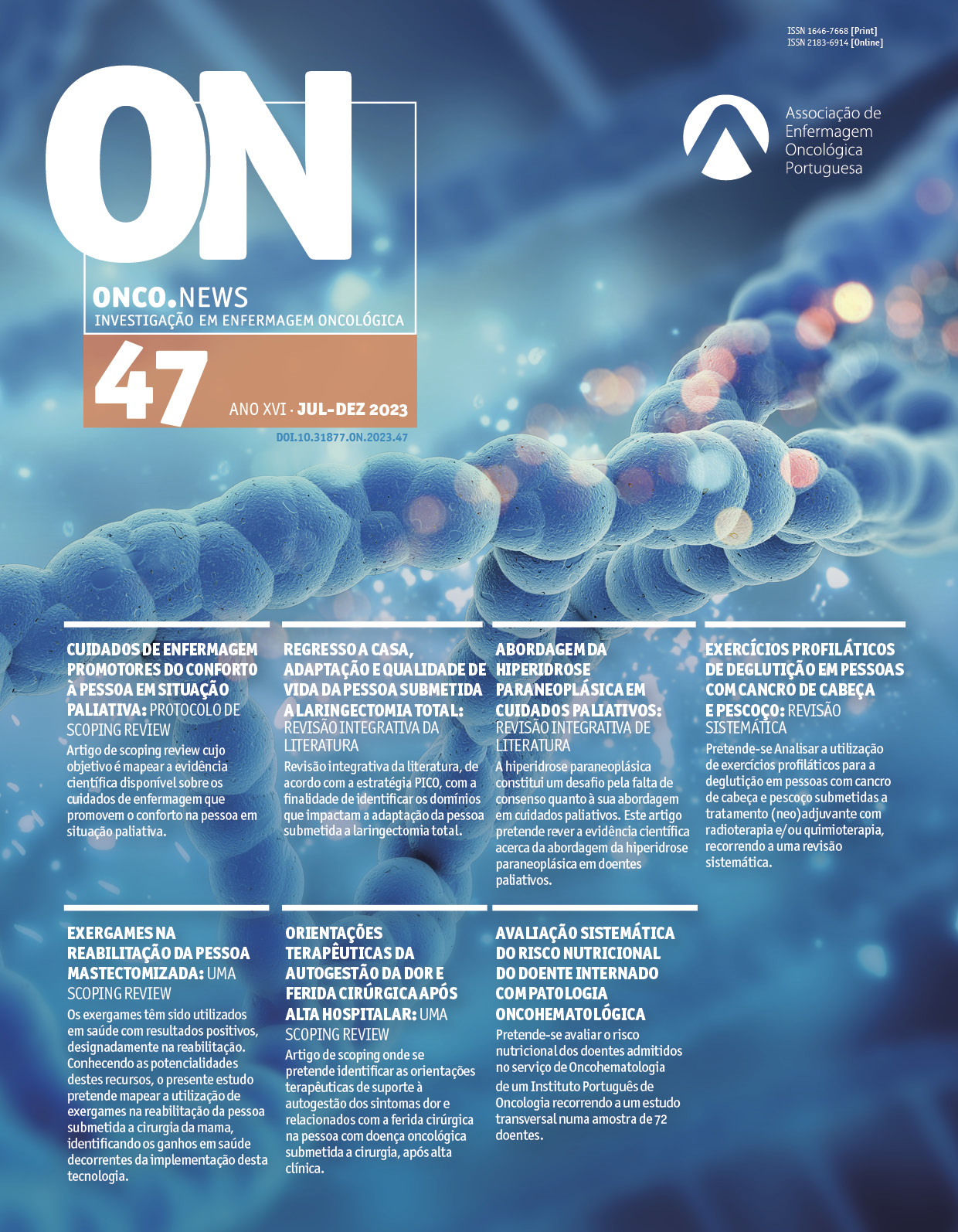Approach to paraneoplastic hyperhidrosis in palliative care: a literature review
DOI:
https://doi.org/10.31877/on.2023.47.01Keywords:
Sweating, Hyperhidrosis, Palliative Care, Palliative Medicine, Hospice CareAbstract
Introduction: This article reviews the current scientific evidence on the approach to paraneoplastic hyperhidrosis in patients receiving palliative care.
Methods: Our search was conducted in MEDLINE/Pubmed®, Cochrane, DARE®, BMJ EBM®, NICE®, CMAJ® and Bandolier, using the MeSH terms “Sweating”, “Hyperhidrosis”, “Palliative Care”, and “Palliative Medicine”. We used the Oxford scale to assess the quality of the included studies.
Results: This review includes 13 articles on the therapeutic approach to paraneoplastic hyperhidrosis using the following interventions: thioridazine, thalidomide, olanzapine, gabapentin, cannabinoids, acupuncture and Chinese herbal medicine. We obtained heterogeneous results and, while these interventions are in general beneficial for controlling paraneoplastic hyperhidrosis in palliative care, no robust evidence exists that unequivocally demonstrates one approach is more beneficial than another.
Conclusions: At present, the available evidence on the therapeutic approach to paraneoplastic hyperhidrosis in palliative care has low quality (Level of Evidence 4; Strength of Recommendation C).
Downloads
References
Nawrocki S, Cha J. The etiology, diagnosis, and management of hyperhidrosis: A comprehensive review: Therapeutic options. Journal of the American Academy of Dermatology [Internet]. 2019;81(3):669–80.
Mercadante S, Porzio G, Valle A, Fusco F, Aielli F, Adile C, et al. Orphan symptoms in advanced cancer patients followed at home. Supportive Care in Cancer. 2013 Oct 13;21(12):3525–8.
Tsai JS, Wu CH, Chiu TY, Chen CY. Significance of Symptom Clustering in Palliative Care of Advanced Cancer Patients. Journal of Pain and Symptom Management. 2010 Apr 1;39(4):655–62.
Grond S, Zech D, Diefenbach C, Bischoff A. Prevalence and pattern of symptoms in patients with cancer pain: A prospective evaluation of 1635 cancer patients referred to a pain clinic. Journal of Pain and Symptom Management. 1994 Aug;9(6):372–82.
Tsai JS, Wu CH, Chiu TY, Hu WY, Chen CY. Symptom patterns of advanced cancer patients in a palliative care unit. Palliative Medicine. 2006;20(6):617–22.
Zhukovsky DS. Fever and sweats in the patient with advanced cancer. Hematology/Oncology Clinics of North America. 2002 Jun;16(3):579–88.
Zasowska-Nowak A, Ciałkowska-Rysz A. Hyperhidrosis in palliative care patients. Medycyna Paliatywna/Palliative Medicine. 2017;9(2):79-83.
Cherny N, Fallon M, Kaasa S, Portenoy RK, Currow DC, editors. Oxford Textbook of Palliative Medicine. Oxford Medicine Online. Oxford University Press; 2015. p.724-739.
Dalal, S. Arthur, JA. Overview of sweating in palliative care. UpToDate. Consultado a 16 de novembro de 2022.
Twycross R. Sweating in advanced cancer. Advances in Palliative Medicine. 2004;3(2):179–88.
Quigley CS, Baines M. Descriptive epidemiology of sweating in a hospice population. Journal of Palliative Care. 1997;3(1):22–6.
Regnard C. Use of low dose thioridazine to control sweating in advanced cancer. Palliative Medicine. 1996;10:78–9.
Cowap J, Hardy J. Thioridazine in the management of cancer-related sweating. Journal of Pain and Symptom Management. 1998;15(5):266.
Abbas SQ. Use of thioridazine in palliative care patients with troublesome sweating. Journal of Pain and Symptom Management. 2004 Mar;27(3):194–5.
Deaner P. Thalidomide for distressing night sweats in advanced malignant disease. Palliative Medicine. 1998 Apr;12(3):208–9.
Calder K, Bruera E. Thalidomide for night sweats in patients with advanced cancer. Palliative Medicine. 2000 Jan;14(1):77–8.
Deaner PB. The use of thalidomide in the management of severe sweating in patients with advanced malignancy: trial report. Palliative Medicine. 2000;14(5):429-31.
Zylicz Z, Krajnik M. Flushing and Sweating in an Advanced Breast Cancer Patient Relieved By Olanzapine. Journal of Pain and Symptom Management. 2003 Jun;25(6):494–5.
Porzio G, Aielli F, Verna L, Porto C, Aloisi P, Cannita K, et al. Gabapentin in the treatment of severe sweating experienced by advanced cancer patients. Supportive Care in Cancer. 2006 Jan 10;14(4):389–91.
Maida V. Nabilone for the Treatment of Paraneoplastic Night Sweats: A Report of Four Cases. Journal of Palliative Medicine. 2008 Aug 21;11(6):929–34.
Carr C, Vertelney H, Fronk J, Trieu S. Dronabinol for the Treatment of Paraneoplastic Night Sweats in Cancer Patients: A Report of Five Cases. Journal of Palliative Medicine [Internet]. 2019 Oct 1;22(10):1221–3.
INFARMED. Deliberação N.º11/CD/2019. 2019.
Hallam C, Whale C. Acupuncture for the Treatment of Sweating Associated with Malignancy. Acupuncture in Medicine. 2003 Dec;21(4):155–6.
Chiu SC, Lai YL, Chang HH, Chang KH, Chen ST, Liao HF, et al. The therapeutic effect of modified Yu Ping Feng San on idiopathic sweating in end-stage cancer patients during hospice care. Phytotherapy Research. 2009 Mar;23(3):363–6.
Huang Y, Chang HH, Chiu SC, Lai YL, Chen YJ. Modified Dang Gui Liu Huang Tang Eases Sleep Sweats in Elderly Patients with Terminal Cancer. International Journal of Gerontology. 2016 Jun 1;10(2):96-9.
Downloads
Published
How to Cite
Issue
Section
License
Copyright (c) 2023 Sandra Ribeiro, Sara Inês Sousa, Sara Ferreira , Michael Luis

This work is licensed under a Creative Commons Attribution-NonCommercial-ShareAlike 4.0 International License.




